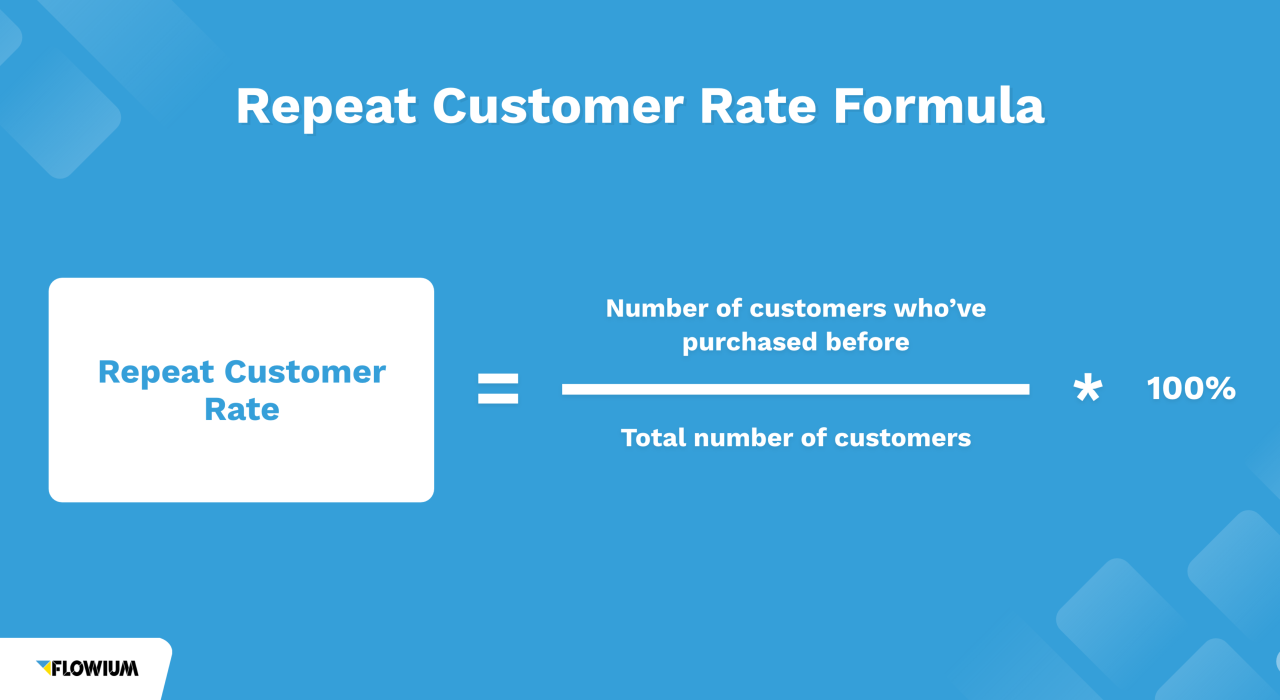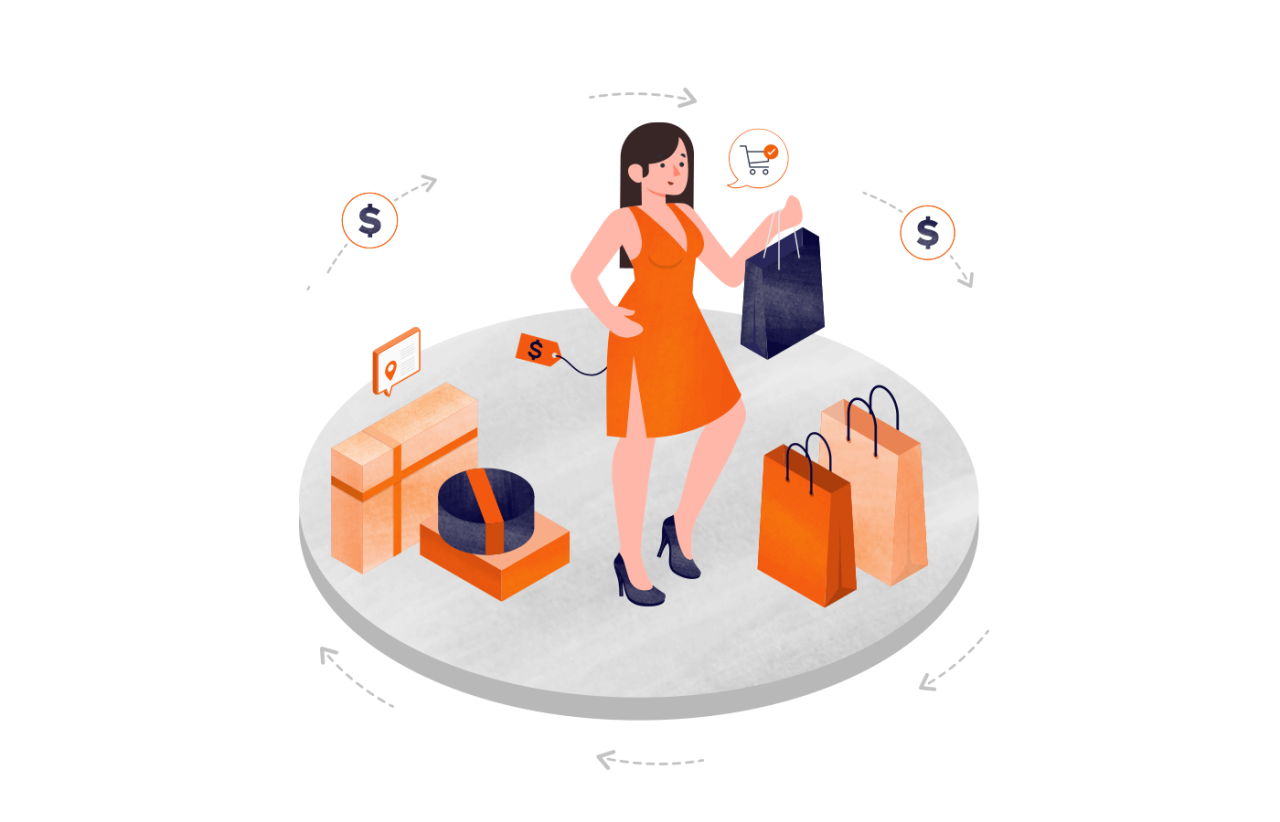What counts as a repeat customer for businesses? It’s a question that seemingly has a simple answer, but the reality is far more nuanced. Defining a repeat customer goes beyond simply counting transactions; it delves into the complexities of purchase frequency, the time elapsed between purchases, the value of those purchases, and even customer behavior online. Understanding these different facets is crucial for accurate customer segmentation, effective marketing strategies, and ultimately, boosting business profitability.
This exploration will unpack various metrics—transaction-based, time-based, value-based, and behavioral—to paint a comprehensive picture of what constitutes a repeat customer. We’ll examine the limitations of relying solely on purchase frequency, the importance of customer lifetime value (CLTV), and how integrating different data points can provide a more accurate and insightful understanding of your loyal customers. Ultimately, we aim to equip you with the tools and knowledge to identify, segment, and retain your most valuable repeat customers.
Defining Repeat Customer: What Counts As A Repeat Customer For Businesses
Defining a repeat customer solely based on the number of transactions can be misleading and may not accurately reflect the true value or loyalty of a customer. While purchase frequency is a valuable metric, it’s crucial to consider other factors to obtain a comprehensive understanding of customer behavior and lifetime value.
Limitations of Transaction Frequency as the Sole Metric
Relying solely on transaction frequency to define repeat customers overlooks crucial aspects of customer behavior. A customer might make only one purchase but spend a substantial amount, demonstrating higher value than a customer making multiple small purchases. Conversely, frequent purchases might be driven by promotional offers or convenience, not necessarily strong brand loyalty. This narrow focus can lead to inaccurate customer segmentation and ineffective marketing strategies. Ignoring the monetary value associated with repeat purchases can skew the perception of customer lifetime value (CLTV).
Examples Where Transaction Frequency is Insufficient
Consider a luxury car dealership. A customer purchasing a high-end vehicle once a year contributes significantly more revenue than a customer purchasing inexpensive accessories weekly. Similarly, a bespoke tailor who serves a small clientele with high-value custom orders will have a different customer profile than a fast-fashion retailer with numerous frequent buyers of low-cost items. In both instances, focusing solely on transaction frequency would misrepresent the true value of their customer base. Another example would be a high-end jewelry store, where a single, large purchase might significantly outweigh dozens of smaller transactions from other customers.
Transaction Frequency Thresholds and Customer Segmentation
The following table illustrates different transaction frequency thresholds and their implications for customer segmentation. It highlights the potential biases associated with using frequency alone.
| Frequency (Transactions in 12 Months) | Customer Type | Business Impact | Potential Bias |
|---|---|---|---|
| 0 | One-time customer | Low impact, potential for reactivation | Overlooks potential for future high-value purchases |
| 1-3 | Occasional customer | Moderate impact, requires targeted engagement | Underestimates value if transactions are high-value |
| 4-6 | Regular customer | Significant impact, opportunities for loyalty programs | May not capture highly valuable infrequent customers |
| >6 | High-frequency customer | Very significant impact, potential for advocacy | Risk of over-saturation with promotions |
Strategies for Handling Infrequent, High-Value Customers
Customers with infrequent but high-value purchases require a different approach than high-frequency customers. Instead of focusing on transaction frequency, prioritize personalized communication, exclusive offers, and dedicated customer service. Building strong relationships through proactive outreach and understanding their specific needs is crucial for retaining these valuable customers. Consider implementing a VIP program tailored to their preferences, offering personalized recommendations, and providing exceptional customer support. This strategy focuses on building long-term relationships rather than solely incentivizing frequent transactions.
Defining Repeat Customer: What Counts As A Repeat Customer For Businesses

Understanding repeat customers is crucial for sustainable business growth. While simply tracking repeat transactions offers a basic understanding, incorporating time-based metrics provides a more nuanced and valuable perspective on customer loyalty and engagement. This allows businesses to segment customers based on their purchasing frequency and predict future behavior more accurately. This section will delve into the intricacies of defining repeat customers using time-based metrics.
Time-Based Metrics for Defining Repeat Customers: Advantages and Disadvantages
Using the time elapsed between purchases to define repeat customers offers several advantages. It provides a more comprehensive view of customer loyalty than transaction-based metrics alone, capturing the rhythm of customer engagement. For instance, a customer making two purchases in a single day might be considered a repeat customer transactionally, but their engagement might be better understood if analyzed through a time-based lens. However, choosing the appropriate time interval is crucial. Using too short an interval might classify infrequent buyers as repeat customers, while using too long an interval might miss out on identifying valuable repeat customers who purchase less frequently. Furthermore, time-based metrics can be more challenging to implement and analyze compared to simple transaction counts. Seasonal fluctuations in purchasing behavior can also skew the results, requiring careful consideration of the business’s specific context.
Suitable Time Intervals for Various Businesses
The optimal time interval for defining repeat customers varies significantly across different industries and business models. For businesses with high-frequency purchases, such as grocery stores or coffee shops, a shorter interval, such as a week or even a few days, might be appropriate. In contrast, businesses selling durable goods, like automobiles or appliances, would likely use longer intervals, such as months or even years. Subscription-based services might use monthly or annual intervals to define repeat customers based on subscription renewal. Consider the average purchase cycle and customer behavior when choosing an appropriate time interval. For example, a clothing retailer might define a repeat customer as someone who makes a purchase within three months, while a luxury car dealership might use a twelve-month timeframe.
Determining Optimal Time-Based Repeat Customer Thresholds: A Flowchart
A flowchart can help systematically determine the optimal time-based threshold.
“`
[Start] –> [Define Business Type & Average Purchase Cycle] –> [Consider Industry Benchmarks] –> [Analyze Historical Purchase Data] –> [Test Different Time Intervals (e.g., 7 days, 30 days, 90 days)] –> [Analyze Customer Segmentation & Revenue Generated by Each Segment] –> [Select Interval Maximizing Revenue & Loyalty] –> [Monitor & Adjust as Needed] –> [End]
“`
This flowchart guides the process of analyzing data, testing different time intervals, and selecting the one that best reflects the business’s specific needs and customer behavior. The iterative nature of the process allows for adjustments based on ongoing performance monitoring.
Comparison of Transaction-Based and Time-Based Metrics
Transaction-based metrics simply count the number of purchases a customer makes. This is straightforward but lacks context regarding the frequency and timing of those purchases. Time-based metrics, on the other hand, provide a richer understanding of customer engagement by considering the time elapsed between transactions. While transaction-based metrics are easily implemented, they may overestimate repeat customer rates in businesses with high-frequency, low-value transactions. Conversely, time-based metrics offer a more refined picture of customer loyalty, but require more sophisticated data analysis and careful consideration of the chosen time interval. A combined approach, using both transaction-based and time-based metrics, often provides the most comprehensive view of repeat customer behavior. For example, a business might define a repeat customer as someone who has made at least two purchases within a six-month period. This approach leverages both the simplicity of transaction counts and the nuanced understanding of purchasing frequency provided by time-based metrics.
Defining Repeat Customer: What Counts As A Repeat Customer For Businesses

Understanding repeat customers is crucial for sustainable business growth. While simply defining a repeat customer as someone making a second purchase is a starting point, a more nuanced approach considers the long-term value each customer brings. This involves moving beyond basic purchase frequency and recency to incorporate the concept of Customer Lifetime Value (CLTV).
Customer Lifetime Value (CLTV) in Defining Repeat Customers
CLTV represents the total revenue a business expects to generate from a single customer throughout their entire relationship. It’s a powerful metric because it shifts the focus from individual transactions to the overall profitability of customer relationships. A high CLTV indicates a highly valuable repeat customer, regardless of how frequently they purchase. Conversely, a customer might purchase frequently but have a low CLTV due to low average order value or high acquisition costs. Understanding CLTV allows businesses to prioritize customer retention and optimize their strategies for maximizing long-term profitability.
Methods for Calculating CLTV and its Relevance to Business Strategies
Several methods exist for calculating CLTV, ranging from simple to complex. A basic approach involves estimating the average purchase value, purchase frequency, and customer lifespan. For example:
CLTV = Average Purchase Value x Average Purchase Frequency x Average Customer Lifespan
More sophisticated models incorporate factors like customer churn rate and discount rate to provide a more accurate prediction. The chosen method depends on the data available and the complexity desired. Regardless of the method, the resulting CLTV data is invaluable for strategic decision-making. Businesses can use CLTV to assess the return on investment (ROI) of marketing campaigns, evaluate the effectiveness of customer retention strategies, and prioritize customer segments for targeted outreach. For instance, a business might allocate more resources to retaining high-CLTV customers than acquiring new ones.
Factors Influencing CLTV Beyond Purchase Frequency and Recency
While purchase frequency and recency are important indicators, numerous other factors influence CLTV. These include:
- Average Order Value (AOV): Higher AOV directly increases CLTV.
- Customer Churn Rate: A lower churn rate extends the customer lifespan and boosts CLTV.
- Customer Acquisition Cost (CAC): A lower CAC improves the profitability of each customer and increases CLTV.
- Upselling and Cross-selling Success: Effectively upselling and cross-selling increases the average purchase value and CLTV.
- Customer Loyalty and Engagement: Highly engaged and loyal customers tend to have higher CLTV.
- Product/Service Profitability: The profit margin on products or services directly impacts CLTV.
Understanding these factors allows businesses to develop targeted strategies to improve CLTV. For example, implementing a loyalty program can increase customer engagement and reduce churn, leading to a higher CLTV. Similarly, optimizing pricing and product offerings can increase AOV.
Segmenting Customers Based on CLTV to Identify High-Value Repeat Customers
Once CLTV is calculated, businesses can segment their customers based on this metric. This allows for targeted marketing and retention efforts. For example, a business might segment its customers into high, medium, and low CLTV groups. High-CLTV customers might receive personalized offers, exclusive access to new products, or proactive customer support, while low-CLTV customers might receive less intensive marketing. This targeted approach optimizes resource allocation and maximizes the return on customer relationship management (CRM) efforts. By focusing on high-CLTV repeat customers, businesses can ensure that their efforts are concentrated on the most valuable segments of their customer base.
Defining Repeat Customer: What Counts As A Repeat Customer For Businesses

Understanding repeat customers goes beyond simply tracking repeat transactions. A truly comprehensive view incorporates behavioral data, offering a richer understanding of customer loyalty and future purchase intent. By combining transactional and behavioral insights, businesses can build more effective strategies for customer retention and growth.
Website Engagement as a Supplement to Transaction Data
Website engagement metrics provide valuable context to transaction data, revealing the depth and quality of customer interaction. While a purchase confirms a transaction, engagement metrics illustrate the customer journey leading up to that purchase and their ongoing relationship with the brand. For instance, a customer who makes a single purchase but spends a significant amount of time browsing product pages, reading reviews, and interacting with the website’s content demonstrates a higher level of engagement and potentially a greater likelihood of becoming a repeat customer than one who makes the same purchase but spends minimal time on the site. Analyzing page views, time spent on site, bounce rate, and other engagement metrics in conjunction with purchase history paints a more complete picture of customer behavior.
Behavioral Data Indicative of Loyalty and Repeat Purchase Intent
Several behavioral data points strongly suggest customer loyalty and a propensity for repeat purchases. High website engagement, as previously discussed, is a key indicator. Other significant signals include: frequent newsletter subscriptions and opens, consistent social media engagement (likes, comments, shares), participation in loyalty programs, positive online reviews, and referrals to friends and family. For example, a customer who consistently engages with your brand’s social media content, frequently opens email newsletters, and leaves positive product reviews is far more likely to make repeat purchases than a customer who only interacts with your website during the purchase process.
Utilizing CRM Data to Track Behavioral Patterns
Customer Relationship Management (CRM) systems are crucial for tracking and analyzing behavioral patterns. Effective CRM implementation involves integrating data from various sources, including website analytics, email marketing platforms, and social media channels. This integrated approach enables businesses to build a holistic view of customer interactions. For example, a CRM system can track a customer’s website visits, email opens, purchase history, and customer service interactions, allowing businesses to identify patterns and predict future behavior. This data can be segmented to identify high-value repeat customers, enabling personalized marketing and retention strategies.
Integrating Data for a Comprehensive Repeat Customer Profile
Creating a comprehensive repeat customer profile requires a robust system for integrating transaction, time, value, and behavioral data. This can be achieved through a well-structured CRM or a custom-built data warehouse. The system should track:
- Transaction Data: Purchase frequency, total spend, average order value, products purchased.
- Time Data: First purchase date, last purchase date, time between purchases, days since last interaction.
- Value Data: Customer lifetime value (CLTV), profitability, and contribution margin.
- Behavioral Data: Website engagement metrics, email engagement, social media interactions, customer service interactions, and loyalty program participation.
By combining these data points, businesses can create detailed customer profiles that reveal valuable insights into customer behavior, loyalty, and future purchase potential. This integrated approach allows for more accurate prediction of repeat purchases and enables the development of targeted strategies to nurture and retain high-value customers. For instance, a customer with a high CLTV, frequent purchases, high website engagement, and positive online reviews would be classified as a highly valuable repeat customer, requiring a tailored retention strategy focusing on personalized offers and proactive communication.
Addressing Customer Churn and Retention
Repeat customers are the lifeblood of any successful business. Understanding and managing customer churn, the rate at which customers stop doing business with a company, is crucial for sustained growth and profitability. The relationship between repeat customers and customer churn is inversely proportional: higher repeat customer rates directly correlate with lower churn rates. Effectively managing churn translates to increased customer lifetime value and a more stable revenue stream.
Customer churn is a significant cost for businesses. Replacing lost customers is far more expensive than retaining existing ones. This includes the cost of acquiring new customers through marketing and sales efforts, onboarding new clients, and the potential loss of revenue during the transition. Therefore, strategies focused on reducing churn and increasing customer retention are paramount for long-term financial health.
Strategies to Reduce Churn and Increase Retention
Reducing customer churn requires a multi-faceted approach. It involves understanding *why* customers leave and proactively addressing those concerns. This often involves improving customer service, enhancing product quality, and building stronger customer relationships. Data analysis plays a crucial role in identifying at-risk customers and tailoring retention strategies accordingly. Proactive communication, personalized offers, and loyalty programs are effective tools in fostering customer loyalty and reducing churn. For example, a subscription service might offer a discount for early renewal or provide exclusive content to loyal subscribers. A SaaS company might implement a robust onboarding process to ensure customers quickly understand and utilize the product’s full capabilities, reducing the likelihood of early cancellation.
Examples of Businesses Effectively Managing Customer Churn
Netflix, a leader in the streaming industry, exemplifies effective churn management. Their focus on providing a vast library of diverse content, coupled with personalized recommendations and user-friendly interface, keeps subscribers engaged. They continuously invest in original programming and actively monitor user feedback to improve their service and address potential concerns. Similarly, Amazon’s Prime membership program, with its bundled benefits, creates a strong incentive for customer retention. The convenience and value proposition of Prime significantly reduce churn compared to individual purchases. These companies understand that ongoing engagement and value creation are key to minimizing customer attrition.
Best Practices for Retaining Repeat Customers, What counts as a repeat customer for businesses
Effective repeat customer retention requires a proactive and customer-centric approach. The following best practices are crucial for minimizing churn and maximizing lifetime value:
- Proactive Customer Service: Address customer issues promptly and efficiently. Go the extra mile to exceed expectations.
- Personalized Communication: Tailor communications to individual customer preferences and needs. Use data to segment customers and deliver relevant messaging.
- Loyalty Programs: Reward repeat customers with exclusive discounts, benefits, and early access to new products or services.
- Regular Feedback Collection: Actively solicit customer feedback through surveys, reviews, and direct communication to identify areas for improvement.
- Continuous Product Improvement: Regularly update and improve products or services based on customer feedback and market trends. Innovation is key to keeping customers engaged.
- Community Building: Foster a sense of community among customers through social media, forums, or exclusive events.
- Data-Driven Decision Making: Utilize customer data to identify at-risk customers and proactively intervene with tailored retention strategies.






